Picks have been used by guitarists since they were invented many years ago and we use them to strum chords and pick notes with greater precision, and accuracy, and also to minimize the stress on our hands. Felt picks tend to be used by ukulele and bass players, but there’s no reason why guitarists can’t use them too.
We’re probably all familiar with plastic guitar picks, but they can also be made out of leather, metal, or wood. Some guitarists use a coin. Here we’re going to discuss how to use a felt pick on the guitar including how to hold it and how to get the best sound from the guitar when using one.
Playing the guitar with a felt pick is much the same as playing with a plastic pick in terms of technique, so if you’ve already played with a plastic pick, you should adjust easily. However, the felt pick will produce a much softer sound compared to any other kind of plastic pick.
So why would a guitar player choose a felt pick over a plastic one? Is there a certain style of music that would sound better with a felt pick? How do you decide which pick to use for which song? We’re going to look at these questions in a lot more detail going forward.
Using A Felt Pick on the Guitar [What You Need to Know]
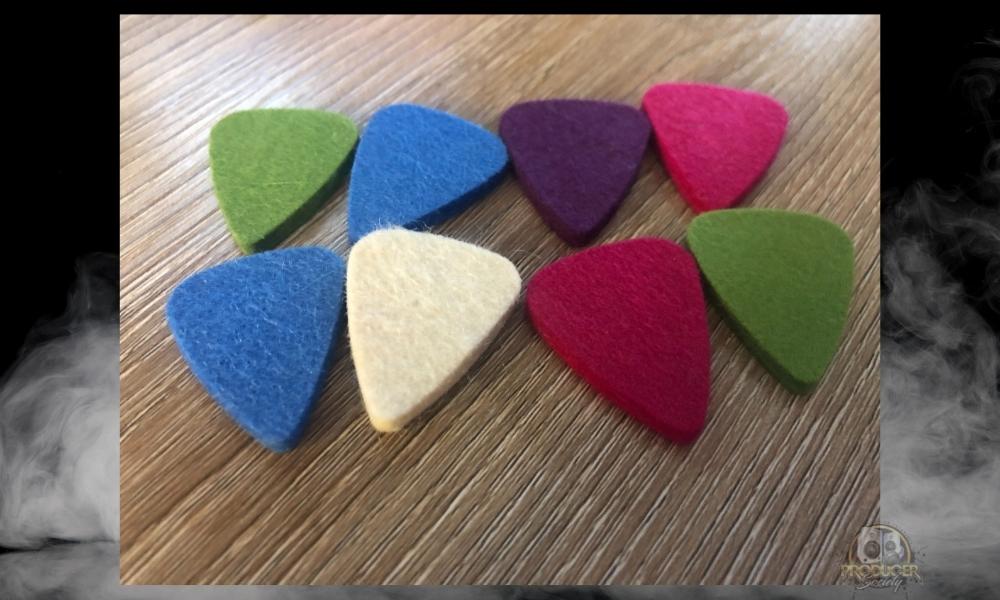
Generally speaking, felt picks are used by ukulele players – which is something discussed in my other article – and sometimes by bass players who want a softer attack on their notes.
They’re great for guitar players who are transitioning to the ukulele. I bought my first felt pick not long after I got this ukulele on Amazon. The first time you play with a felt pick you might not like the sound and you may also find it awkward to hold.
It’s worth giving it a good practice session and trying different techniques to hold the pick at different angles before you decide it’s no good.
Also, try different styles of music. I’ll admit that I don’t use mine often, but I know there will come a day when I’ll be glad I bought it. I’ve made a video showing how it sounds down below which you can check out shortly, but first, there is one thing I want to tell you about.
1) Bend the Felt Pick Back and Forth to Soften It
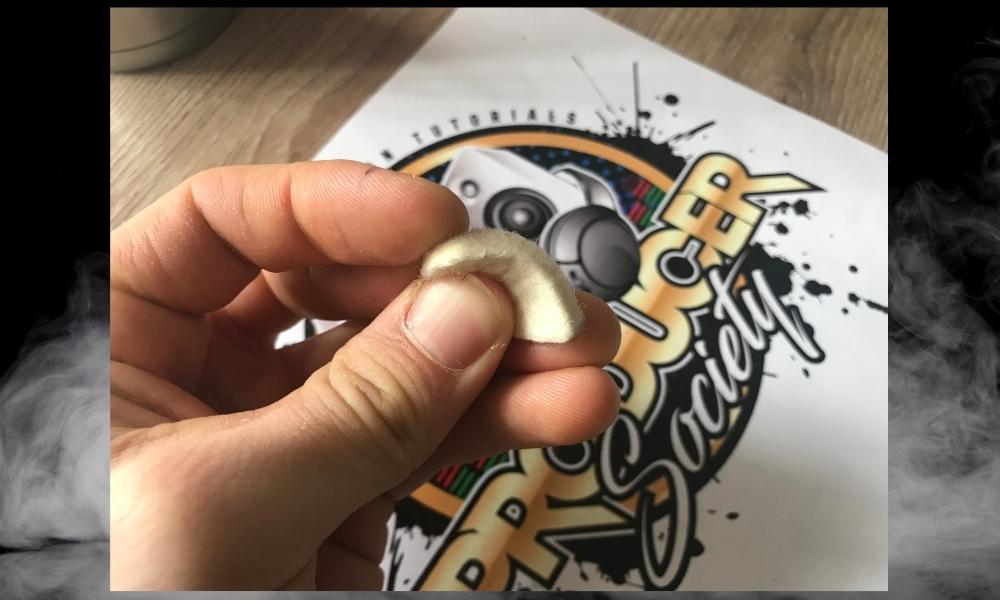
If you’ve never held a felt pick in your hand, you might be thinking that it couldn’t have much substance to it. But in reality, they’re quite thick and fairly hard to use as well. That’s why you need to bend it (in my opinion, at least).
When you use a brand new felt pick it will need softening before it will glide well across the strings. In order to do this, bend the pick many times back and forth to soften it up. Don’t be afraid to play with it – it won’t break as easily as you think.
2) Grip the Felt Pick The Same As You Would With A Guitar Pick
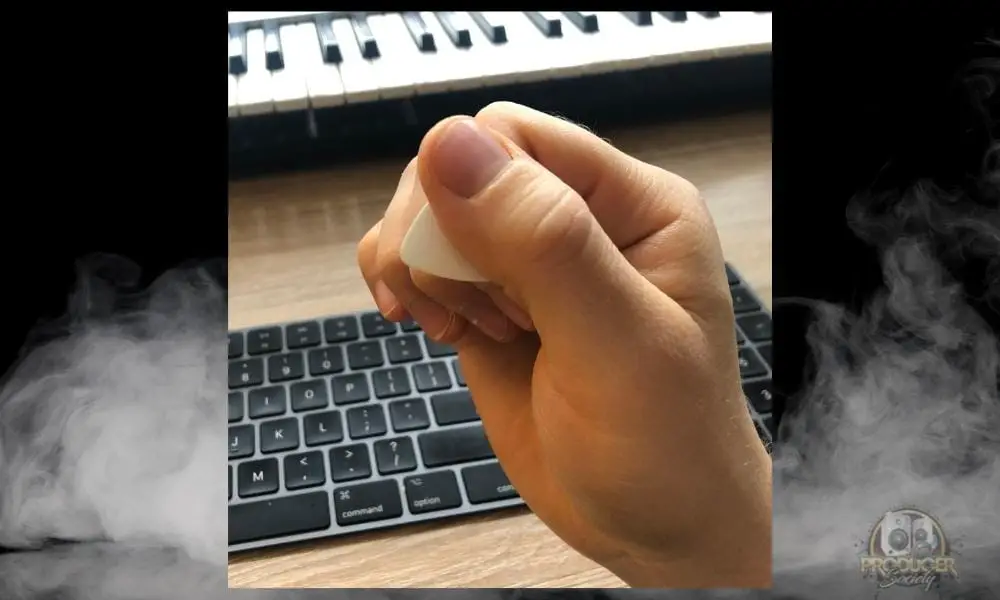
When you use a pick, you need to hold it with the long side of the triangle in your hand and the pointy tip of the triangle at the top to meet the strings. Place the long side of the pick on the side of your forefinger by the first and second knuckles.
Hold it in place very firmly by bringing your thumb down on top of it. Roll your thumb slightly away from the pointy tip to get a firm grip and the feeling of being in control. This is the same way for how it works on the mandolin as well which I already wrote about.
3) Strum the Strings With the Pick
To begin strumming across the guitar strings, turn your wrist very slightly in the opposite direction you’ll be strumming so that the tip of the pick is leaning a bit in the opposite direction.
In other words, if you’re strumming down, you want the pick to lean upwards a little bit. When you strum up, twist your wrist very slightly the other way so the pick is leaning a little bit up toward the top of the guitar.
Notice that if you hold the pick straight onto the guitar strings it’s much more difficult to glide across the strings and you get a much harsher sound. I haven’t made my own video on this yet, so here’s one that does a good job.
Why Use A Felt Pick for the Guitar
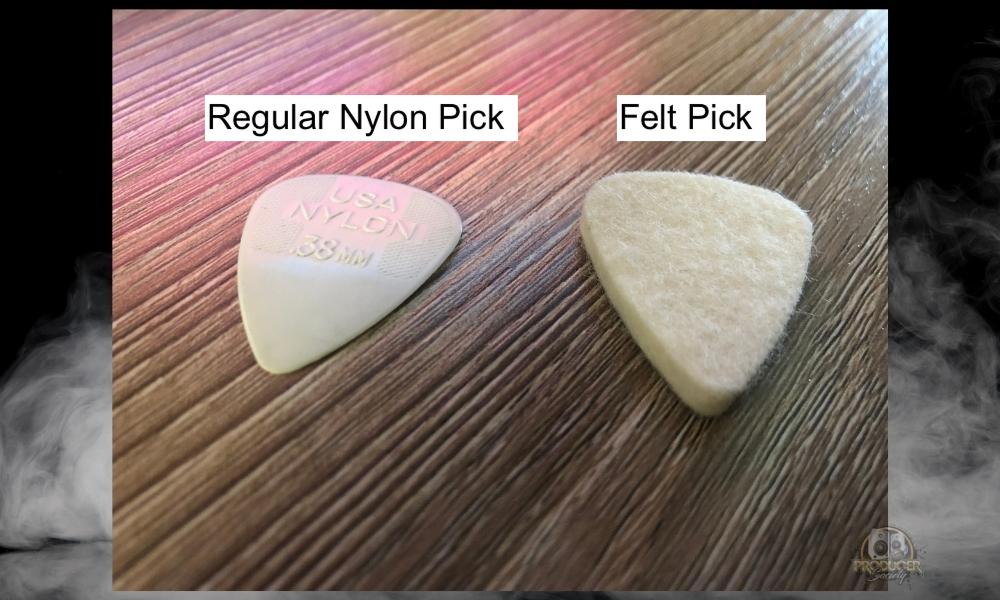
A felt pick isn’t better or worse than a plastic pick, but it certainly does produce a different sound. What type of sound depends on the tone of the guitar you’re playing, but generally, you’ll find the following things to be true.
1) Felt Picks Have A Much Softer Tone
If you take a look at the video that I show here, you can hear a noticeable difference between the way the regular 0.65mm Delrin pick sounds and the Felt pick. For one, the felt pick is definitely quieter, and this has to do with the lower-end frequencies.
The Delrin pick, like most thinner picks, sounds a lot “pluckier” than the felt pick. The felt pick is practically noiseless which is the way most thicker picks tend to be, with the exception of steel, stone, and wood.
For instance, you don’t hear the Jazz III very much when strumming, although, a Jazz III is a lot harder to strum with than a felt pick. It takes considerable practice to get a handle on super thick picks.
2) Felt Picks Are Much Quieter
When you pluck a guitar string with a plastic pick, the plastic pick hitting the string collides to create a strong attack at the beginning of the sound. This creates a bold, percussive sound at the start of each strummed chord or plucked note.
Certain styles of music require a gentler sound to them. Using a felt pick will eliminate this percussive element and replace each strum or pluck with a much softer attack. The word, “soft,” really can’t be emphasized enough.
3) They’re Bigger So They’re Easier to Hold
Felt picks are the same shape as plastic ones and are held in the same way. However, they are much thicker, and some are larger overall. This is so that they have some strength – otherwise, they’d bend against the string and hardly produce any sound.
I enjoy using a felt pick quite a lot simply because it’s so novel and unusual. At this point, I have practically every kind of guitar pick known to man, and I’ve got more coming in the mail right now.
4) They Take Some Getting Used To
Watching this YouTube video demonstrates that it does not always love at first try. A guitarist at Kevys RC & Music struggles to produce a sound he likes using a felt pick on a guitar.
However, when he switches to playing bass, he gets more comfortable with it. I feel the same way as he does in the video, although, I would say that bending it a few times before you start is a great way to work it in before even starting to play.
When Should You Use A Felt Pick Over A Regular Guitar Pick?

Felt picks sound great in music that is softer and more atmospheric than a style of music that needs a strong consistent beat, such as rock. Felt picks have been used successfully in jazz guitar playing and also certain folk music.
I would argue that it could probably be used to great effect with a fuzz pedal as well as a slide. You could get some really warm, fuzzy, and low-end tones with a felt pick, slide, and a fuzz pedal.
Obviously, we have to mention ukulele music as well which felt picks are made for, if I’m not mistaken.
Disadvantages of Felt Picks

1) They’re Not Great for Playing Fast
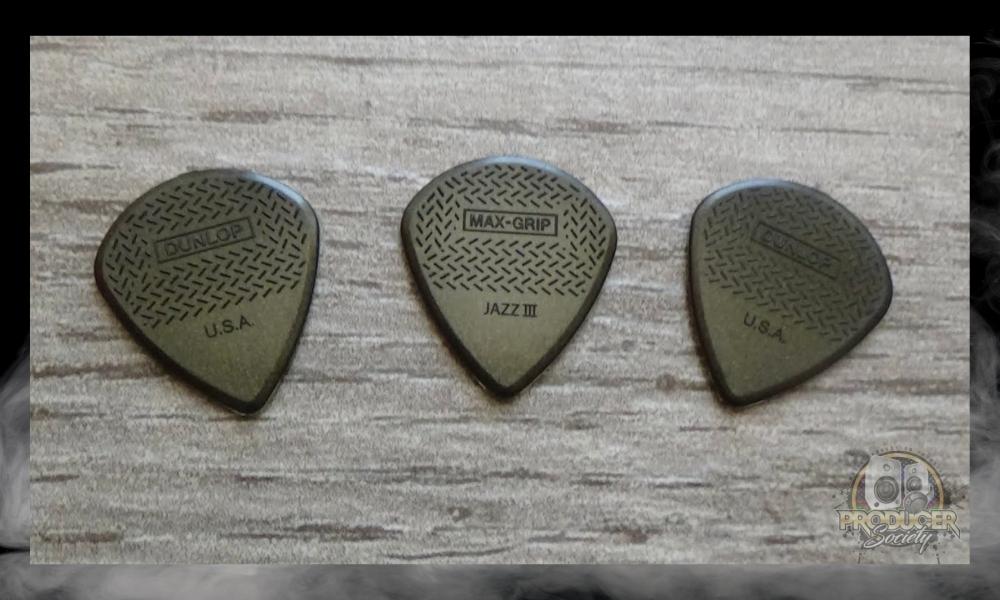
Due to the softer texture of felt, it’s more difficult to produce notes in quick succession. Felt picks are easier to master and more effective when strumming or plucking slowly.
The Dunlop Jazz III’s that are shown in the image above are what I’m using at the moment, although, I also have some Kirk Hammett Jazz III’s and Ernie Ball Prodigies coming in the mail as well. I’ll give those a test soon.
2) Felt Picks Don’t Have Great Attack
As noted earlier, the attack created with a felt pick is far slower than with a rigid pick such as plastic. But this can be a plus if you’re playing a song that requires a more romantic sound.
3) They Can Be Too Soft – Or Too Hard
Depending on the thickness of the pick, felt picks can give you a sense of not having enough control over your playing.
Having said that, as stated earlier, there are some stiff felt picks that you might feel need a bit of breaking in to soften them first.
4) Felt Picks Aren’t for Alternate Picking or Sweep Picking
Related to the first point on speed and precision, a felt pick won’t be great for any shred techniques at all, particularly alternate picking. Alternate picking requires a change in direction after each and every note.
For instance, when you’re playing a scale of some kind with several notes on the same string, you’ll find it easier to use an alternate picking technique. It involves plucking one string and letting the pick fall against the next string.
If your pick is too soft – i.e. made of felt – it wouldn’t be easy to control the steps of this tricky technique at all.
5) They’re Usually Not A Great Choice for Players Who Use Distortion or Overdrive
Using distortion or overdrive generally requires a strong attack on the note or chord to make it work convincingly. You might find that the softer attack with a felt pick is too gentle to create the right effect.
But like I said a moment ago and as I’ll say again in a second, this could be an interesting experiment for finding your own unique tone.
Other Articles You May Be Interested In
Important Things to Note
1) Use Felt Picks To Be Creative and Different
Felt picks, because of how different they sound and how unconventional they are, can be used in a way that other guitarists have never seen or heard before. For example, almost no guitar player uses a felt pick.
This is a great way to set you apart from other players, similar to how Brian May, the guitarist from Queen, uses a penny.
2) Picks Aren’t Limited to Felt or Plastic
Picks can be made of any material you like. You might find a really small, slim pebble on the beach that would create an interesting sound. A scrap of coconut shell could give a unique sound (I also own coconut picks, although, I wouldn’t recommend them).
Don’t be afraid to experiment. Play around with some felt picks of different sizes and thicknesses. Try some different materials to use as picks and see how they sound when you add overdrive and fuzz. Try different combinations.
You might even develop a completely new technique for playing guitar. Developing your own distinct sound on the guitar is an exciting thing to do and can make you stand out from the crowd.

 Written By :
Written By :